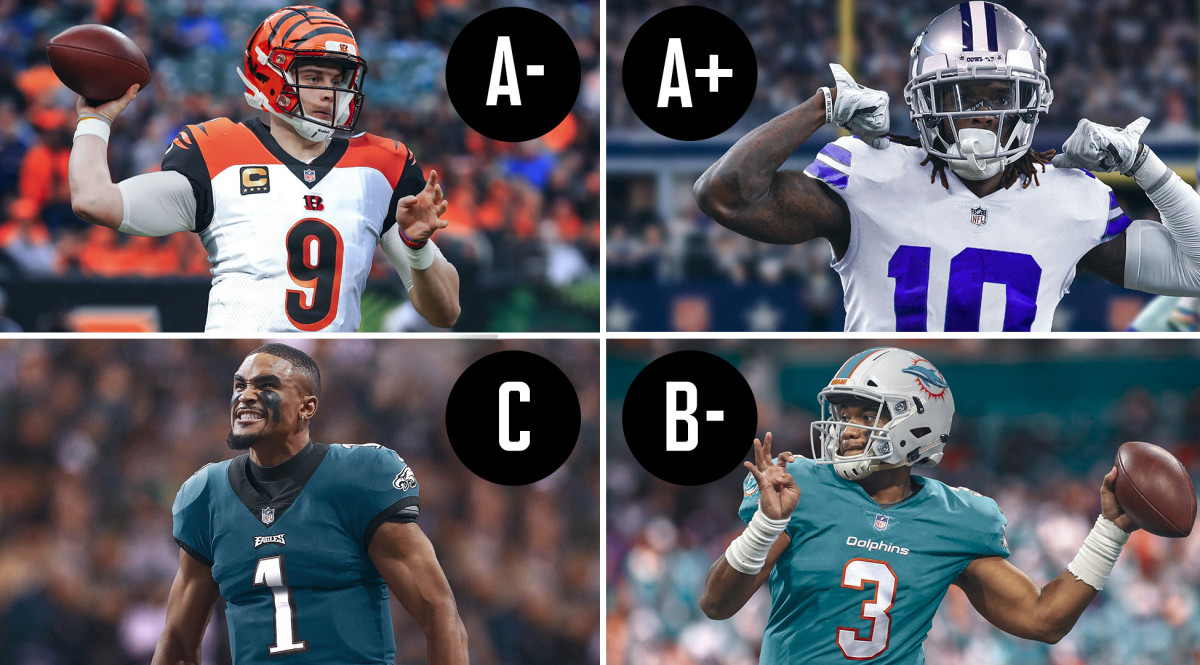SI gave us a B-
MIAMI DOLPHINS
1 (5). Tua Tagovailoa, QB, Alabama
1 (18). Austin Jackson, T, USC
1 (30). Noah Igbinoghene, CB, Auburn
2 (39). Robert Hunt, T, Louisiana
2 (56). Raekwon Davis, DT, Alabama
3 (70). Brandon Jones, S, Texas
4 (111). Solomon Kindley, G, Georgia
5 (154). Jason Strowbridge, DE, North Carolina
5 (164). Curtis Weaver, DE, Boise State
6 (185). Blake Ferguson, C, LSU
7 (246). Malcolm Perry, WR, Navy
With four of this draft’s first 39 picks, this was a productive Step 2 in Miami’s multi-year rebuilding process. Step 1 was cleaning house and introducing a new coaching staff in 2019. Step 3 will be repeating Step 2, as the Dolphins have two first-rounders and two second-rounders in 2021.
At pick No. 5, the Tua Tagovailoa represents a perfect outcome for Stephen Ross’s team. 2019’s “Tanking for Tua” slogan proved false, but only because the Dolphins played so much better in the second half of the season and fell in the draft order. Tagovailoa’s late-season hip injury may have been a blessing in disguise, as none of the other QB-needy teams traded up to get him.
That hip is reportedly healed, and there is time for it to get even stronger as the Dolphins don’t need Tagovailoa to play right away. But it’d be a surprise if he’s not the starter come mid-November. The Dolphins are still in the early phases of a massive rebuild, and stopgap veteran Ryan Fitzpatrick can be counted on for at least a half-dozen of the type of head-scratching interceptions that get a quarterback benched.
Tagovailoa’s draft status also speaks to the expanding definition of an NFL quarterback. Ten years ago, a small-statured, good-but-not-great-armed QB would have never gone fifth overall. But football IQ, athleticism and intangibles have become even more valued at the position. Still, for Tagovailoa to succeed, the Dolphins must support him with a strong cast and crisply defined system. He projects to the NFL as more of a timing and rhythm passer than a Russell Wilson-style playmaker.
The Austin Jackson selection made sense, too. The Dolphins had just drafted a quarterback who must be protected. They had an extremely limited offensive line in 2019, and signing free agent left guard Ereck Flowers alone was not enough to change things in 2020. So, they used their next first-round pick on a left tackle. Jackson likely wasn’t atop their offensive tackle board (there were rumors that they were trying to trade for the No. 3 overall pick), but he is a long-bodied, flexible athlete who showed competitiveness at USC.
They also found a right tackle shortly after Jackson—another wise move. Miami entered this draft with glaring needs at both tackle spots, considering that young veterans Julie’n Davenport and Jesse Davis are both better suited for utility backup roles. Some had suggested Robert Hunt, who is a compact 6'5", 323 with just 33.5-inch arm, might play guard in the NFL. But given that Ereck Flowers was just signed to a surprisingly expensive contract to play left guard, and Michael Deiter was drafted in the third round last year to play right guard, the plan at this point is likely for Hunt to be a right tackle.
Defensively, it was about finding players who fit head coach Brian Flores’s Patriots-style scheme. With just two years of cornerback experience, converted wide receiver Noah Igbinoghene is a gifted but raw prospect. The athleticism and competitiveness he showed at Auburn is mandatory in the man-to-man-intensive scheme that Miami is aggressively investing in. With pricey ex-Cowboy Byron Jones and pricey incumbent Xavien Howard on the roster, it’s possible the Dolphins plan on grooming Igbinoghene for a role in the slot. At 5' 10", 198 he has the measurables to play inside or outside. More likely, though, is the Dolphins just pounced on raw talent that they’d like to groom and figure they’ll decide on a long-term role later in the process.
Joining Igbinoghene in the secondary is the third-rounder Brandon Jones. Incumbents safeties. Adrian Colbert and Steven Parker were not bad down the stretch last season, but neither is a surefire starter (though Parker is young and worth monitoring). Expect Jones to get a long look in centerfield first and foremost.
Up front, Raekwon Davis is a somewhat less-heralded prospect, but he has potentially explosive trench-fighting traits and is built for the gritty, two-gap plugging tactics that Miami’s scheme often calls for on first and second down. Before the draft, the only real scheme fits in this sense on Miami’s roster were last year’s first-rounder Christian Wilkins and space-clogging nose tackle Davon Godchaux.
Grade: B-
Which teams had successful NFL drafts, and who could be struggling next season? Handing out grades for every team’s draft.

www.si.com



















